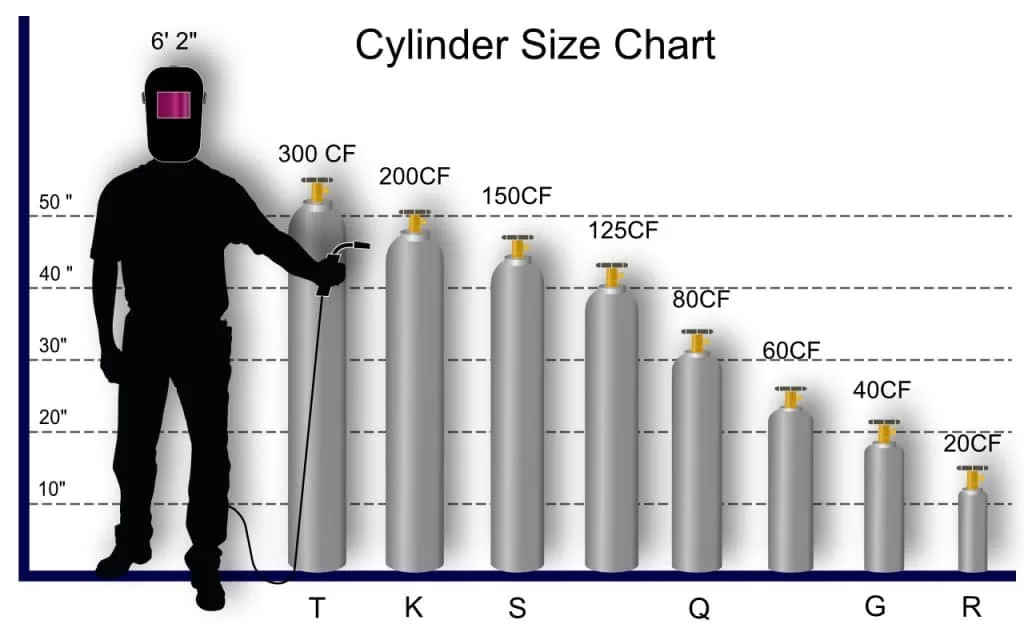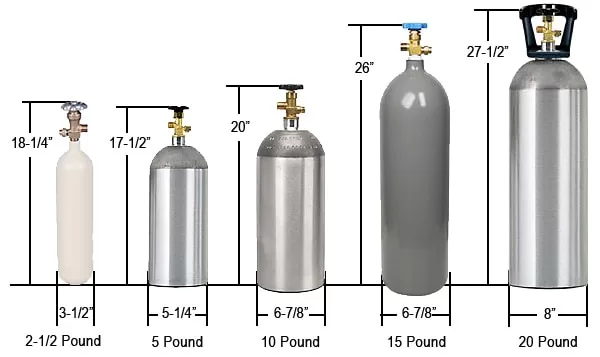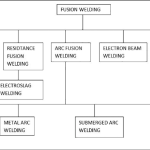If you’re new to the world of MIG welding or TIG welding, the prospect of estimating your welding needs, especially in terms of welding gas, might seem a bit overwhelming. Understanding the longevity of a welding gas bottle is crucial before investing in a specific cylinder size, especially considering the variety available in the market.
What Size Welding Gas Cylinder for MIG or TIG? Argon|CO2
Welding Town
In this guide, I aim to demystify this aspect for you. We’ll delve into the expected welding time you can derive from the most popular cylinder sizes commonly chosen by hobbyists. Additionally, I’ll provide insights on comparing physical dimensions to ensure that the selected gas bottle aligns with the spatial constraints of your welding setup, be it in your vehicle or on your welding cart.
By the time you finish this quick read, you’ll be well-equipped with the knowledge to make an informed decision on the ideal size for your welding gas cylinder. Let’s embark on this journey of understanding and choosing the perfect companion for your welding ventures.
Popular Welding Gas Bottle Sizes For MIG And TIG
In the realm of welding gas tanks, the choices abound, but the 40, 80, or 125 cubic feet (cf) cylinders stand out as the preferred options for most welders. Whether you’re into MIG welding with assorted mixtures or opting for Argon gas in TIG applications, these sizes have become staples in the welding community.
For those who prioritize extended welding sessions with minimal interruptions, the 125 cf tank emerges as a popular choice. Undoubtedly, its larger capacity ensures ample welding time between refills, although the trade-off comes in the form of increased weight and length. Despite these considerations, maneuvering and lifting the tank remain manageable for the majority of users.
On the flip side, the compact 40 cf cylinder offers unparalleled portability. Easily carried to job sites with just one hand, it becomes the go-to option for remote work or those engaging in welding tasks with lower volume requirements.
Finding a middle ground, the 80 cf cylinder strikes a balance that resonates with many casual welders. Offering a harmonious blend of runtime and handling convenience, it has earned its status as the sweet spot for those seeking efficiency without compromising on ease of use.
In essence, whether you lean towards the robust 125 cf tank, the nimble 40 cf option, or the well-rounded 80 cf choice, each size caters to specific needs, ensuring that you can weld with confidence, knowing your gas cylinder is aligned with your welding style and preferences.
Factors To Consider When You Are Deciding On A Welding Gas Tank Size
The nature of your projects, available space, your work frequency, portability, and even your location plays an important role in determining the best-sized welding gas cylinder for you.
Measuring The Welding Time: CFH and LPM
Calculating the total time for any welding gas tank size is quite simple. You can use the following formula to find the time in hours.
- Welding time (hours) = Gas bottle volume in cubic feet (cf) / flow rate in in cfh
- How long a particular gas tank can support you is determined by the flow rate. As a welder, you are in charge of determining the required flow rate for a specific job and work with it.
- To measure the welding shielding gas flow rate, either CFH
- Argon Tank Sizes for MIG or TIG Welding
- (cubic feet hour)or LPM (liters per minute) is used. The flow rate most welding professionals usually work on is in the range of 15 – 35 cfh (7-16.5 lpm).
- However, there is no such thing as one size fits all solution. The optimal flow of your shielding gas depends on the welding process and the material or environmental conditions.
For those who are more interested in the technicalities, higher than required flow introduces turbulence in the shielding gas.
This turbulence gives atmospheric gasses a chance to contaminate the welded joint and reduce its quality.
| CYLINDER VOLUME | 300 cu.ft | 150 cu. ft | 80 cu. ft | 40 cu.ft |
|---|---|---|---|---|
| FLOW RATE | ||||
| 15 CFH | 20hrs | 10hrs | 15.3hrs | 2.6hrs |
| 20 CHF | 15hrs | 7.5hrs | 4hrs | 2hrs |
| 25 CFH | 12hrs | 6hrs | 3.2hrs | 1.6hrs |
| 30 CFH | 10hrs | 5hrs | 2.6hrs | 1.3hrs |
| 35 CFH | 8.6hrs | 4.3hrs | 2.3hrs | 1.2hrs |
Recommended Argon/CO2 MIG Bottle Sizes
Metal Inert Gas (MIG) welding is a type of arc welding that uses a consumable electrode to join two metal pieces in a weld pool.
The process is quite straightforward and uses a shielding gas to keep impurities and air to interact with the welded part.
Generally, MIG welding uses a steady supply of shielding gas for protection. You have to select from the common welding gas cylinder sizes given below.
It depends on several factors like your gas choice, how frequently you weld, and your usual volume.
| SIZE | 300 | 200 | 150 | 125 | 80 | 60 | 40 | 20 |
|---|---|---|---|---|---|---|---|---|
| VOLUME cf (m3) | 300 cf (8.5m³) | 200 cf (5.6m³) | 150 cf (4.2m³) | 125 cf (3.5m³) | 80 cf (2.6m³) | 60 cf (1.6m³) | 40 cf (1.1m³) | 40 cf (.56m³) |
| HEIGHT | 55 (140cm) | 51 (130cm) | 47 (120cm) | 43 (110cm) | 32 (81cm) | 23 (58cm) | 17 (43cm) | 14 ( 35cm) |
| DIAMETER | 9.25 (24cm) | 9 (23cm) | 7 ( 18cm) | 7 ( 18cm) | 7 ( 18cm) | 7 ( 18cm) | 7 ( 18cm) | 5 (13cm) |
Can’t find these sizes at your local gas supplier? Don’t panic, it’s more common than you think.
The tabulated data is from Matheson Gas, one of the many industrial suppliers of welding gasses.
It is important to mention that the welding gas tank sizes are usually not according to a specific standard because no such thing exists.
This is a common problem when it comes to gas bottles as each manufacturer tries to introduce a unique character to its gas bottle.
So, focus more on the capacity rather than class names. If you can’t find a specific class size, just focus on the characteristics and get the closest one.
Welding Gas Cylinder Specifications (Argon/MIG Blends)
Keep in mind that specifications vary among compressed gas cylinder manufacturers. And because you may see a high-pressure cylinder labeled by a letter, number, or content weight, I’ve also included this information in the chart.
| Size | 40 cf (#2/V) | 80 cf (#3/Q) | 125 cf (#4/D) |
|---|---|---|---|
| Height | 22 in. | 35 in. | 45 in. |
| Diameter | 6½ – 7¼ in. | 6½ – 7¼ in. | 6½ – 7¼ in. |
| Empty Weight | 24 lbs. | 47 lbs. | 58 lbs. |
| Full Weight | 28 lbs. | 56 lbs. | 71 lbs. |
| Full Pressure | 2015 PSI | 2015 PSI | 2265 PSI |
*All weights and dimensions are approximate.
Small tanks of 20 cf or less capacity aren’t commonly used to TIG or MIG weld. You see these tanks used in portable oxy-acetylene gas welding kits.
While larger cylinders over 125 cf are available, very few are customer-owned, instead, most are leased or rented from the gas supplier.
Because these enormous tanks are tough to handle and may cause damage or injury if dropped, they’re usually delivered by the supplier to high-volume customers.
Welding Gas Tank Size Chart

Of course, the larger the tank, the more economical the refills. While you won’t pay much more to get twice the gas, the savings won’t offset the ongoing tank rental cost for low-volume users.
My last purchase of an 80 cf cylinder from a “local” supplier 20 miles from my home took about an hour and a half of my time and cost way more than it should have.
I ended up “purchasing” a tank that was not new, needed a new hydro-test in just five years, and had the gas company’s name stamped on the neck ring.
To top it off, the fine print on my receipt stated the tank was refillable only by them!
At that time, I didn’t realize there was an easier way. I thought all the cylinders for sale online were empty.
Recommended 100% Argon TIG Bottle Sizes
The requirements of TIG welding are slightly different from MIG. Tungsten Inert Gas (TIG) welding was introduced in the 1940s and became an immediate success. One of the reasons behind this process’s popularity is the precise and aesthetic results it delivers.
It’s also the go-to process for experienced welders TIG welding mild steel, aluminum and stainless steel.
Tig welding gasses play a crucial part in this process. When compared to MIG welding, TIG is more unforgiving to shielding errors and requires an experienced hand.
The TIG welding process uses a greater amount of shielding gasses, so using bigger cylinders is recommended.
This is especially true in the case of purging stainless steel, which prevents the welded metal from oxidizing in air.
Even if you have a small TIG welding setup, it is recommended to select a larger tank either K or a T-class gas cylinder for the best experience. You can opt for smaller welding gas tanks as well, but you’ll have to make frequent refilling trips to the market.
A Better Way To Buy A Full Welding Tank
Later, I learned that I could have a full 80cf cylinder delivered to my door at a great price. These bottles meet DOT standards and are hydro-tested.
The company guarantees the tank will have a minimum of eight years left on the hydro-test. Just don’t confuse the “2015” pressure stamp for the test date when checking.
Because they come with a blank neck ring, the tanks are refillable by a supplier of your choice.
Any decent gas supplier won’t have a problem refilling a good quality customer-owned cylinder. Some large outfits don’t want to deal with low-volume users, so it’s a good idea to check your local options.
I recommend looking for a small, helpful gas supplier like the one in this video. He shows what cylinder sizes are popular with hobbyists, along with what to look for when buying gas cylinders.
100% CO2 Gas Cylinders For MIG
For greater penetration and lower-operating costs, some prefer to use pure carbon dioxide instead of a MIG mixture.
The 100% CO2 gas cylinders used for MIG welding differ from MIG blends or an Argon tank.
What to know:
- CO2 tanks use different valves so you’ll need an adapter.
- CO2 tanks are filled by weight, instead of volume.
- One pound of CO2 provides 8.741 cf of shielding gas.
- Freezing can damage a regulator not rated for 100% CO2.
100% CO2 (C100) Cylinder Sizes and Operating Time
| Size | H x W (in) | CU FT | Time* |
|---|---|---|---|
| 1.25# | 10.5 x 3 | 10.9 | 33 min. |
| 5# | 18.25 x 5.5 | 43.7 | 2.2 hrs. |
| 10# | 20.5 x 7 | 87.4 | 4.4 hrs. |
| 20# | 27.5 x 8 | 174.8 | 8.8 hrs. |
| 50# | 47 x 8 | 437.1 | 21.9 hrs. |
*Approximate welding time at 20 cfh flow rate
How Long Does Welding Gas Last?
How much welding time you’ll get per bottle will depend on the flow rate you set on the regulator. The setting is usually between 10 and 40 cubic feet per hour (cfh) depending on the work environment.
You’ll need a higher flow rate to maintain shielding gas protection in a windy area. Even with my garage door open 12 inches, I get good results with the regulator set to 20 cfh for MIG as long as it’s calm.
Since we’re dealing only in cubic feet, our welding-time calculation for gas cylinders is simple:
Gas welding time (hours) = [cylinder volume (cf)] / [flow rate (cfh)]
So, using my 80cf cylinder, with the regulator set to 20 cfh, then:
Welding Time = (80 cf) / (20 cfh) = 4.0 hours
Welding Time Calculated for Cylinder by Gas Flow Rate (Argon/MIG blends)
| Flow rate | Tank Size | ||
|---|---|---|---|
| 40 cf | 80 cf | 125 cf | |
| 10 cfh | 4.0 hrs | 8.0 hrs | 12.5 hrs |
| 15 cfh | 2.7 hrs | 5.3 hrs | 8.3 hrs |
| 20 cfh | 2.0 hrs | 4.0 hrs | 6.3 hrs |
| 30 cfh | 1.3 hrs | 2.7 hrs | 4.2 hrs |
| 40 cfh | 1.0 hrs | 2.0 hrs | 3.1 hrs |
Of course, these are calculated times and your real-life results will vary. Significant temperature swings, the frequency of start and stops, and pre/post-flow settings will affect your actual run time.
It’s a good practice to check your regulator occasionally as you weld. As the gas level decreases, the cylinder pressure drops, causing the flow rate to change on single-stage regulators. Again, temperature changes have the same effect, so don’t be surprised if you’re adjusting the regulator more often than you expected.
I’ve picked up the habit of backing out the gas regulator adjustment to “0” when I finish welding for the day. Manufacturers recommend this to remove spring pressure from the valve diaphragm. This practice also forces me to adjust gas flow the next time I weld.
How Much Gas is Left in the Tank?
With 100% CO2, you’ll need to weigh the tank to know how much remains.
With Argon and Argon/CO2 blends, the pressure gauge provides an estimate of the remaining gas.
With a full welding gas cylinder at 70 degrees, the pressure gauge should read near the working pressure stamped near the neck. This is usually 2015 or 2265 psi.
Without a drastic temperature change or a leak, you can expect the pressure to respond in a straight line to the remaining gas volume.
So, if your full cylinder started with 2000 psi on the pressure gauge, a reading of 1000 psi tells you that roughly 50% of your gas remains.
Some pressure gauges are more accurate than others, especially in the lower range. But as long as the regulator is maintaining the set flow while the trigger is pulled, you can keep on welding, knowing that your weld is protected.
Don’t be concerned if you notice the gauge seems to hold steady for a time, then suddenly drops. The slow gas discharge rate that we use in welding can cause the pressure dial to hang up temporarily. It won’t take long before you get a feel for the accuracy of your pressure gauge.
Conclusion
Now that you’ve seen how long welding gas will last and the most popular tank sizes, I hope you know what size welding gas cylinder is right for you so you can get started with MIG or TIG welding soon!











